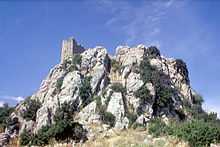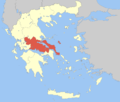Orchomenus (Boeotia)
| Orchomenos Ορχομενός | |
|---|---|
 | |
 Orchomenos | |
|
Location within the region  | |
| Coordinates: 38°29′N 22°59′E / 38.483°N 22.983°ECoordinates: 38°29′N 22°59′E / 38.483°N 22.983°E | |
| Country | Greece |
| Administrative region | Central Greece |
| Regional unit | Boeotia |
| Area | |
| • Municipality | 436.4 km2 (168.5 sq mi) |
| Population (2011)[1] | |
| • Municipality | 11,621 |
| • Municipality density | 27/km2 (69/sq mi) |
| • Municipal unit | 8,869 |
| Time zone | EET (UTC+2) |
| • Summer (DST) | EEST (UTC+3) |
| Vehicle registration | ΒΙ |
Orchomenus (Ancient Greek: Ὀρχομενός Orchomenos), the setting for many early Greek myths, is a municipality and a rich archaeological site in Boeotia, Greece, that was inhabited from the Neolithic through the Hellenistic periods. As of 2011, the population was 11,621. Orchomenus is also referenced as the "Minyean Orchomenus" in order to distinguish the city from the "Arcadian Orchomenus", the latter of which was located in Arcadia near the modern town of Kalpaki.
Municipality
The municipality Orchomenos was formed at the 2011 local government reform by the merger of the following 2 former municipalities, that became municipal units:[2]
- Akraifnia
- Orchomenos
Ancient history



The Neolithic remains found at Orchomenos were first thought to be in situ (Bulle 1907) but it later appeared that they consisted of fill in a levelling deposit (Kunze 1931; Treuil 1983). Thus, the associated round houses (two to six meters in diameter) should not be dated to that period, but rather to the Early Bronze Age (2800-1900 BC). Later in that period, houses were apsidal.
In the Bronze Age, during the fourteenth and thirteenth centuries, Orchomenos became a rich and important centre of civilization in Mycenaean Greece, the latter of which was a rival to Thebes. According to the founding myth of Orchomenos, its royal dynasty had been established by the Minyans, who had followed their eponymous leader Minyas from coastal Thessaly to settle the site. The palace, which had frescoed walls, and the great tholos tombs show the power of Orchomenos in Mycenaean times. A massive hydraulic undertaking drained the marshes of Lake Copaïs. Like many sites around the Aegean, Orchomenos was burned and its palace destroyed, ca. 1200 BC. Orchomenos is mentioned among the Achaean cities sending ships to engage in the Trojan War in Homer's "Catalogue of Ships" in Iliad: together with Aspledon, they contributed thirty ships and their complement of men. Orchomenos seems to have been one of the city-states that joined the maritime Amphictyony in the seventh century BC. Orchemenos claimed Heracles as its champion.
Orchomenos joined the Boeotian League ca. 600 BC. Orchomenos struck its coinage from the mid-sixth century. Classical Orchomenos was known for its sanctuary of the Charites, the oldest in the city, according to Pausanias (5.172-80); the Byzantine (9th century) monastery church of Panaghia Skripou probably occupies the long-sacred spot.[3] Here the Charites had their earliest veneration, in legend instituted by Eteocles; musical and poetical agonistic games, the Charitesia,[4] were held in their honour, in the theatre that was discovered in 1972.[5] The Agrionia, a festival of the god Dionysus, involved the ritual pursuit of women by a man representing Dionysus.
In 480-479 BC, the Orchomenians joined their neighboring rivals the Thebans, to turn back the invading forces of Xerxes in the Greco-Persian Wars. In mid-century, Orchomenos sheltered the oligarchic exiles who freed Boeotia from Athenian control. In the fourth century the traditional rivalry with Thebes made Orchomenos an ally of Agesilaus II and Sparta against Thebes, in 395 and again in 394 BC. The Theban revenge after their defeat of Sparta in the battle of Leuctra (371 BC) was delayed by the tolerant policies of Epaminondas:[6] the Boeotian League sacked Orchomenos in 364 BC. Although the Phocians rebuilt the city in 355 BC, the Thebans destroyed it again in 349.
The broad plain between Orchomenos and the acropolis of Chaeronea witnessed two battles of major importance in Classical antiquity. In 338 BC, after a whirlwind march south into central Greece, Philip II of Macedon defeated Thebes and Athens on the plain of Chaironeia during the First Battle of Chaeronea, establishing Macedonian supremacy over the city-states, and demonstrated the prowess of Philip's young son Alexander the Great. During Alexander's campaign against Thebes in 335 BC, Orchomenos took the side of the Macedonians. In recompense, Philip and Alexander rebuilt Orchomenos, when the theatre and the fortification walls, visible today, were constructed.
The Second Battle of Chaeronea occurred when Roman forces under Lucius Cornelius Sulla defeated those of King Mithridates VI of Pontus near Chaeronea, in 86 BC during the First Mithridatic War. This Second Battle of Chaeronea would be followed by the Battle of Orchomenus, when Archelaus' forces were completely destroyed. Subsequently Orchomenos has remained little more than a village.
Archaeology
In 1880–86, Heinrich Schliemann's excavations (H. Schliemann, Orchomenos, Leipzig 1881) revealed the tholos tomb he called the "Tomb of Minyas", a Mycenaean monument that equalled the "Tomb of Atreus" at Mycenae itself. In 1893, A. de Ridder excavated the temple of Asklepios and some burials in the Roman necropolis. In 1903–05, a Bavarian archaeological mission under Heinrich Bulle and Adolf Furtwängler conducted successful excavations at the site. Research continued in 1970–73 by the Archaeological Service under Theodore Spyropoulos, uncovering the Mycenaean palace, a prehistoric cemetery, the ancient amphitheatre, and other structures.
Minyan ware is a term that was coined to describe a certain type of pottery that was found here.
See also
- Minyans
- Achaean League
- Orchomenus, a king in Greek mythology.
- Erginus, king of Orchomenus.
- Elara and her son Tityos
- Cephissus
- Arcadian Orchomenos, a prehistoric and historic city in Arcadia, Greece
Notes
- ↑ "Detailed census results 2011" (in Greek).
- ↑ Kallikratis law Greece Ministry of Interior (Greek)
- ↑ J. G. Frazer's note on Pausanias, 1898.
- ↑ A. Schachter, Cults of Boiotia I, (1981), pp 140-44, provides the most complete modern account of the Charitesia.
- ↑ Schachter 1981; John Buckler, "The Charitesia at Boiotian Orchomenos" The American Journal of Philology 105.1 (Spring 1984), pp. 49-53.
- ↑ John Buckler, The Theban Hegemony 371-362 B. C. (Harvard University Press) 1980.
References
External links
- Official website (in Greek)
| Wikimedia Commons has media related to Orchomenos (Boeotia). |
| ||||||||||||||||||||||||||||||||||
| ||||||||||
